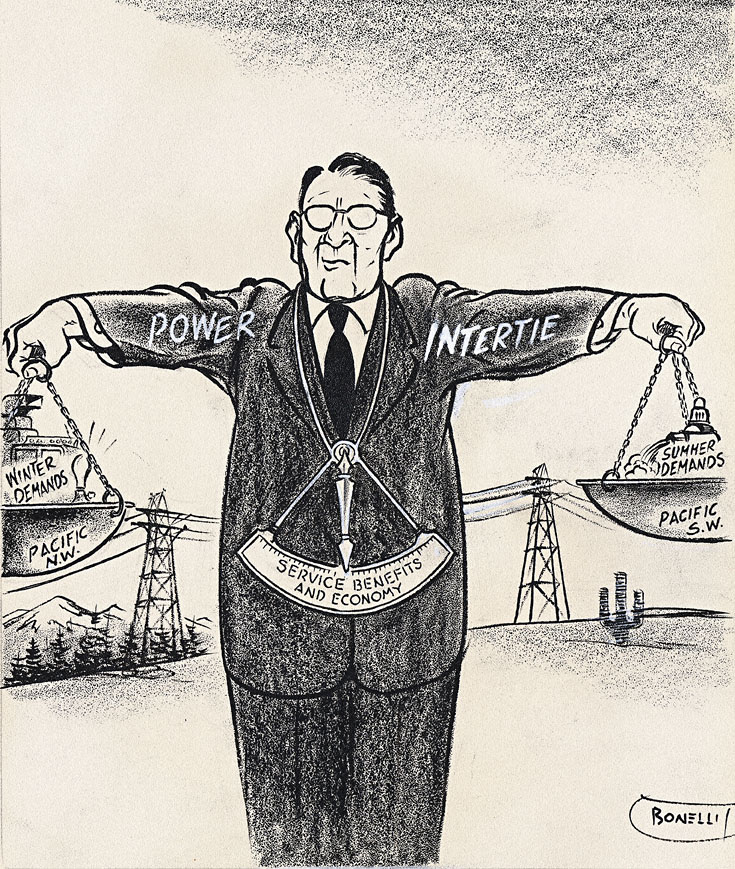- Catalog No. —
- Mss 5537
- Date —
- June 30, 1964
- Era —
- 1950-1980 (New Economy, Civil Rights, and Environmentalism)
- Themes —
- Environment and Natural Resources, Government, Law, and Politics
- Credits —
- Oregon Historical Society
- Regions —
- Columbia River
- Author —
- Carl Bonelli, Oregon Journal
Editorial Cartoon, Fitness Program
This transcript of Secretary of the Interior Stewart L. Udall’s and President Lyndon B. Johnson’s remarks at the intertie victory breakfast at the Sheraton Hotel in Portland, Oregon, was made available by the library of the Bonneville Power Administration (BPA). The victory breakfast brought together many of the most influential politicians and “power men” of the western United States to celebrate two major breakthroughs in their efforts to link the electrical power “grids” of the U.S. West: ratification of the Columbia River Treaty between the United States and Canada and congressional approval of funds to begin construction of a high-voltage transmission system linking the Pacific Northwest and Pacific Southwest. At the same time, the occasion offered the President an opportunity to tout his administration’s conservation achievements and agenda while campaigning for the presidential election.
The Pacific Northwest-Pacific Southwest Intertie is an extra-high-voltage transmission system linking the power grids of the Northwest and Southwest. At the most basic level, it allows for electricity to be exchanged north and south depending upon the power needs of each region. For example, during the hot summer months, air conditioners and irrigation pumps increase energy demands in the Southwest. At the same time, the rivers of the Northwest are swollen with the annual snowmelt, so hydropower operators use their dams to generate electricity, then send it southward to meet their southern neighbors’ needs. Similarly, during cold winter months in the Northwest, spikes in energy uses coincide with the lowest water levels of the year, making energy production unpredictable at times. To meet the needs of northwestern electricity customers, steam-powered generators are “fired-up” in the Southwest and energy is sent north through the intertie to heat people’s homes and businesses.
On August 14, 1964, Congress appropriated $45.5 million for the first phase of the intertie’s construction. On September 16th, one day before the victory breakfast, President Johnson appeared with Canadian Prime Minister Lester Pearson at the Peace Arch International Park in front of a crowd of 10,000 to officially recognize the ratification of the Columbia River Treaty for the joint development of the Columbia River Basin. During the years leading up to both achievements, the two projects became intertwined. Canadian ratification of the treaty hinged on their ability to sell their thirty-year entitlement of “downstream benefits” in electrical power, worth $254.4 million, to electrical utilities in U.S. Northwest. In turn, the availability of the “Canadian entitlement” became a huge incentive to electric utilities in the Southwest to support the construction of the Pacific Intertie. The energy made available from the north allowed utilities in the Southwest to conserve fossil fuels for future uses and to forestall building expensive power plants.
Further Reading:
Norwood, Gus. Columbia River Power for the People: A History of Policies of the Bonneville Power Administration. Portland, Oreg., 1981.
Lowitt, Richard. The New Deal and the West. Bloomington, Ind., 1984.
Written by Joshua Binus, © Oregon Historical Society, 2004.
